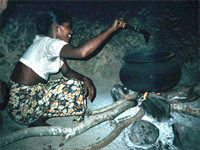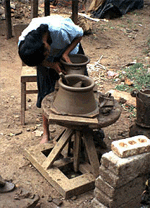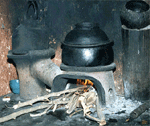:: Specific Design Brief
Practical Action 5:
Sustainable
Cooking - further information
PRODUCT DESIGN SRI LANKA
- METHODS
 The
three stone fire
The
three stone fire
By far the most traditional method of cooking is on the three stone fire. It
is also by the cheapest. All you need are three suitable stones of the same
height on which your cooking pot can be balanced. The problems are obvious
• smoke and steam can cause health problems
• balancing the pot is vital
• only one pot can be used at a time
• there is no heat control
• it is easy for accidents to happen
• fuel is wasted
• attending to the pot and adding fuel both require bending
There are advantages for most people in using the three stone fire and any
new stove needs to consider the following points
• It is convenient
• It involves NO cost at all
• It can cope with a wide range of pot sizes and shapes
• It heats the kitchen area in cold weather
• The smoke is used to process food e.g. fish, meat and cereals to give a
longer life.
 Other
existing methods
Other
existing methods
People in Sri Lanka have been developing improved fires in a bid to cut down
fuel waste and health and safety hazards. They have had considerable
success. One of the improvements is the Anagi stove, developed to reduce the
quantity of biomass needed, to enable two pots to be used at once, and to
cut down health risks.
It has been estimated that the Anagi stove results in a 50% reduction in
biomass usage. As a result it has become very popular with all classes of
people, especially when the price of liquid petroleum gas or kerosene has
risen.
Continuing issues
Although the Anagi stove improved life for many Sri Lankan households there
are still some areas where people are looking to improve its design or
develop a new type of stove.
 Some
of the areas suggested by Dr Amerasekara, the Director of Integrated
Development Association, A Sri Lankan non-government organisation working
with Sri Lankan people are
Some
of the areas suggested by Dr Amerasekara, the Director of Integrated
Development Association, A Sri Lankan non-government organisation working
with Sri Lankan people are
• a stove capable of being used with larger pots suitable for use by small
scale street traders
• a stove capable of coping with a wider variety of sizes and shapes –
current stoves can use stoves of between 20 and 50 cm diameter and usually
manage round-bottomed pots more safely than flat-bottomed
• some kind of hood or chimney to take the smoke and steam away from the
kitchen or area where it is being used
• investigating other sources of fuel to replace wood, especially if it was
waste products from other kinds of work
• a more permanent installation – free standing stoves may only last one
year whereas installation extends life to five years
• developing a simple stand allowing people to work at the correct height
rather than constantly bending or crouching.
What would be the specification for an improved stove?
• Cost is critical. Most current stoves sell for around 100 rupees. (150 rupees
= £1) A loaf of bread sells for about 10 rupees in a Sri Lankan market.
• Something for a small street industry would need to be made for less than 1000
rupees
• Able to support pots with a capacity of 100 litres of liquid.
• Capable of supporting a variety of different shaped and sized pots.
• Capable of adapting for either internal or external use.
• Includes a method of smoke extraction for the kitchen.
• Able to use at least two pots simultaneously.
• Uses locally available materials, preferably clay, since this is the cheapest
material widely available in Sri Lanka. Metal is also available.
• Draught is also very important – the design would need to generate enough
heat, especially for use in a domestic industry.
FURTHER INFORMATION
ENERGY SOURCES